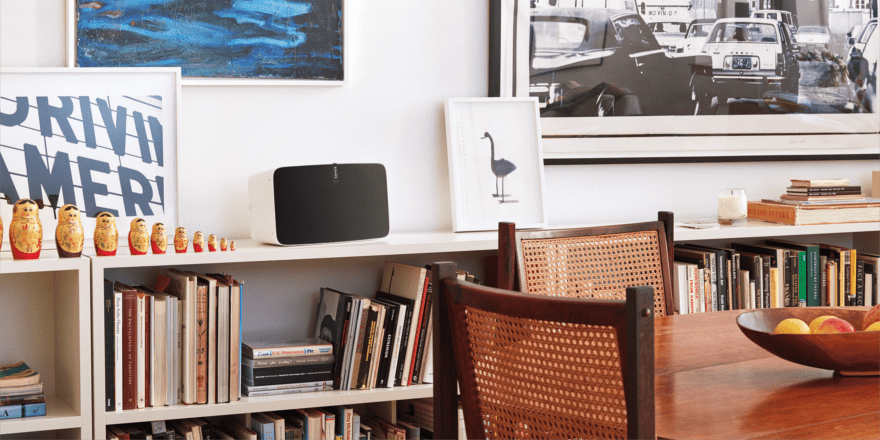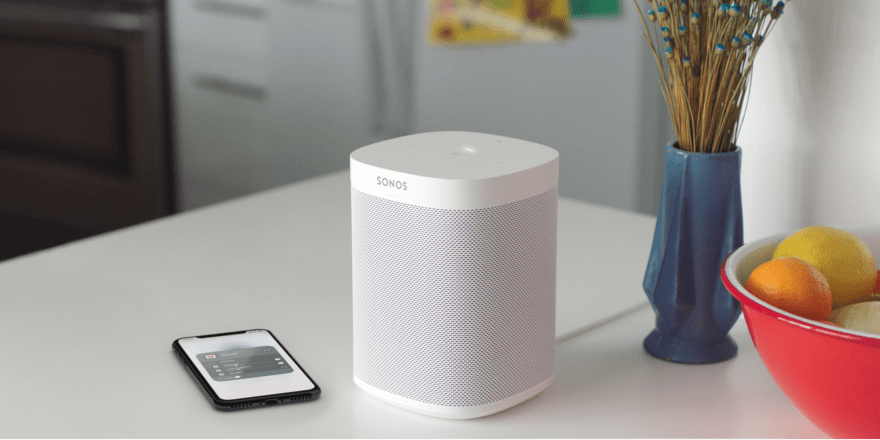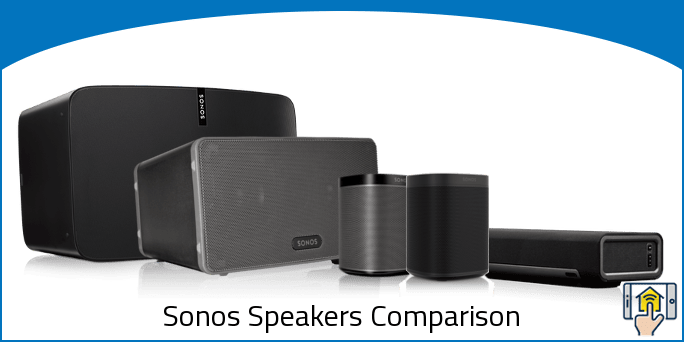The Sonos family of speakers has evolved over time to include products with a wide variety of features and price points. The newer models tend to offer new features, better performance, and smarter control, but every speaker in the company’s product lineup remains a viable option for adding rich sound to your home.
If you’d like to skip the reading, you can jump straight to Sonos Speakers Comparison Chart (Sonos One vs. PLAY:1 vs. PLAY:3 vs. PLAY:5 vs. Play Bar vs. Beam) in order to tell at a glance what each speaker brings to the table.
However, if you’d like to learn more about the product family as a whole and what makes Sonos speakers unique, read on below!
What is the Sonos Speakers Lineup?

There are 7 main Sonos products that make up the speaker lineup, with each model having slight differences that make them suited to meet different needs.
The Sonos ONE is primarily a Mono Output speaker, but it does give the option for Stereo Output if you pair it to other speakers. With 2 Class-D Digital Amplifiers, 1 Tweeter, and 1 Mid-Woofer, it should produce a nice sound (although it’s definitely at the lower end of the product family when it comes to the underlying technology.) Other features include voice control with Amazon Alexa and Siri, with Alexa being built right into the device, humidity resistance, on-device touch controls, and wall mounting.
The has a similar audio setup to the Sonos ONE (mono by default, stereo with other speakers), as well as the same number of amplifiers, tweeters, and mid-woofers. The Play:1 lacks some of the features that make the ONE unique, such as support for Siri and built-in Amazon Alexa, and also opts for button controls rather than on-device touch.
The Sonos PLAY:3 produces Mono output when it’s in a vertical position, and stereo when it’s in a horizontal position. It features an additional amplifier and mid-woofer when compared to the PLAY:1 and ONE, however, the only voice control is through a separate Amazon Alexa device. One other downside is the lack of humidity resistance, making it a poor fit for areas with moisture such as a bathroom or poolside.
The Sonos PLAY:5 has a similar orientation-centric setup to the PLAY:3, although it significantly amps up the equipment with 6 Amplifiers, 3 Tweeters, and 3 Mid-Woofers. You can also connect the speaker to your TV through an AUX cord, control your music using Amazon Alexa, and Siri support is coming soon. The PLAY:5 is also the only speaker from the brand that supports Google Assistant, although you’ll need to connect the device via a line-in port.
The Sonos Playbar is exclusively a stereo device and features the most powerful equipment in the product family with 9 amplifiers, 3 tweeters, and 6 mid-woofers. While it lacks an audio line-in, it’s a great companion to your television set with the ability to connect using a digital optical cable. Voice control through Amazon Alexa is supported, but Siri and Google Assistant integration is nonexistent. Other shortcomings are the lack of humidity resistance and button control rather than touch, although we don’t think those will be a huge issue if you’re using it as a sound system for your TV.
While the Sonos Beam doesn’t have the same equipment as the Playbar (5 Amplifiers, 1 Tweeter, and 4 Mid-Woofers), it makes up for the shortcomings with a better lineup of features. In addition to the digital optical cable, you can also connect the soundbar to your TV using HDMI ARC. Amazon Alexa is built directly into the device, and we believe that Siri is now supported as well.
What Makes Sonos Speakers Special?

What makes Sonos speakers is not necessarily the audio equipment itself. The factor that sets the brand apart from the rest is the huge amount of support for music streaming services — ensuring that you’ll be able to beam your tunes from pretty much anywhere. The Sonos One and Beam also have Alexa build right into the speaker, which is still a rarity with third-party smart speakers.
The speaker lineup also makes it very easy to create a stereo pair by linking two speakers of the same kind. For example, you can take two PLAY:1 speakers and connect them together in order to enjoy a more robust sound at a more affordable price.
This same feature also makes it very easy to expand to a 3.1 or 5.1 system, as the speakers are set up to be expanded on over time. Rather than having to shell out all at once for a huge sound system, you can build your audio setup up over time for an all in one experience that can play different rooms with their own music or work in tandem to blast your favorite song and take your party to the next level.
What is Sonos Trueplay?

Another aspect that makes Sonos unique is their Trueplay technology. While investing in a sound system will likely be an upgrade by default, a lot of the sound improvements will be lost with sub-optimal speaker placement. Trueplay allows you to use an app on iOS devices in order to analyze the room and direct you toward a placement that is perfect for that particular room.
With various room shapes, sizes, and furniture compositions potentially messing with the quality of your sound, Trueplay is a great companion to have on hand in order to ensure you’re getting the most out of your new audio equipment.
What is Sonos 3.1 vs. 5.1?

While it may be tempting to look at our product chart and pick out the newest and most expensive feature, the expandability of the lineup makes the older and less expensive models worth considering.
Even though they might not be very impressive on their own, they can become a force to be reckoned with as you expand your speakers into a 3.1 or 5.1 home theater system. For this reason, we recommend keeping an eye out for the Sonos speakers that will easily integrate with one another rather than jumping straight for a powerful standalone device.
Sure, the mono sound of the Sonos ONE or PLAY:1 isn’t very impressive compared to what the rest of the lineup has to offer, but when you combine the two speakers into a stereo pair you’re going to enjoy comparable audio quality — often at a much lower price.
Long story short — Sonos has built a speaker lineup that manages to keep older technology with fewer features relevant to this day. It’s certainly one of the best brands around if you’re looking for flexibility and compatibility.
Sonos Speakers — Comparison Chart
| Sonos PLAY:3 | Sonos PLAY:5 | Sonos Playbar | Sonos Beam | |||
|---|---|---|---|---|---|---|
| Mono Output | Yes | Yes | In vertical position | In vertical position | No | No |
| Stereo Output | Only when paired with other speakers |
Only when paired with other speakers |
In horizontal position | In horizontal position | Yes | Yes |
| Class-D Digital Amplifiers | 2 | 2 | 3 | 6 | 9 | 5 |
| Tweeter | 1 | 1 | 1 | 3 | 3 | 1 |
| Mid-Woofer | 1 | 1 | 2 | 3 | 6 | 4 |
| Adjustable Bass & Treble Controls | Yes | Yes | Yes | Yes | Yes | Yes |
| A Bass Radiator | No | No | Yes | No | No | Yes |
| Audio Line-in | No | No | No | Yes | No | No |
| Connect to TV | No | No | No | Via AUX Cord | Via Digital Optical Cable | Via Digital Optical Cable or HDMI ARC |
| Voice Control over Amazon Alexa | Yes | Yes | Yes | Yes | Yes | Yes |
| Voice Control Over Siri | Yes | No | No | Coming soon | No | Yes |
| Voice Control Over Google Assistant | No | No | No | Via line-in port | No | No |
| Amazon Alexa Built-In | Yes | No | No | No | No | Yes |
| Trueplay | Yes | Yes | Yes | Yes | Yes | Yes |
| Set Up Over WiFi | Yes | Yes | Yes | Yes | Yes | Yes |
| Humidity Resistant | Yes | Yes | No | Yes | No | No |
| WiFi | 802.11b/g, 2.4 GHz | 802.11b/g, 2.4 GHz | 802.11b/g, 2.4 GHz | 802.11b/g, 2.4 GHz | 802.11b/g, 2.4 GHz | 802.11b/g, 2.4 GHz |
| Bluetooth | No | No | No | No | No | Yes |
| Ethernet Port | 1 | 1 | 1 | 1 | 2 | 1 |
| Size | Small | Small | Medium | Big | Big | Medium |
| Dimensions | 6.36 x 4.69 x 4.69 in. 161.45 x 119.7 x 119.7 mm |
6.36 x 4.69 x 4.69 in. 161.45 x 119.7 x 119.7 mm |
5.2 x 10.6 x 6.3 in. 132 x 268 x 160 mm |
8.03 x 14.33 x 6.06 in. 203 x 364 x 154 mm |
3.35 x 35.43 x 5.51 in. 85 x 900 x 140 mm |
2.70 x 25.625 x 3.94 in. 68.5 x 651 x 100 mm |
| Weight | 4.08 lbs. (1.85 kg) | 4.08 lbs. (1.85 kg) | 5.71 lbs. (2.6 kg) | 14 lbs. (6.36 kg) | 11.9 lbs. (5.4kg) | 6.2 lbs (2.8 kg) |
| Product finish | White w/ white matte grille; Black w/ black matte grille |
White w/ light metallic grille; Black w/ graphite grille |
White w/ light metallic grille; Black w/ graphite grille |
White or black matte enclosure w/ graphite grille |
Black | Black or White |
| On-Device Control | Touch | Button | Button | Touch | Button | Touch |
| One App Control | Yes | Yes | Yes | Yes | Yes | Yes |
| IR Control | No | No | No | No | Yes | Yes |
| Dialog enhancement | No | No | No | No | Yes | Yes |
| Night mode | No | No | No | No | Yes | Yes |
| Wall Mount | Yes | Yes | Yes | Available | Available | Available |
| Change orientation | No | No | Yes | Yes | No | No |
Last update on 2024-04-26 at 04:11 / Affiliate links / Images from Amazon Product Advertising API





